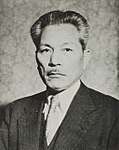1968 Japanese House of Councillors election
House of Councillors elections were held in Japan on 7 July 1968,[1] electing half the seats in the House. The Liberal Democratic Party won the most seats.
| |||||||||||||||||||||||||||||||||||||||||||||||||||||||||||||
125 (of the 250) seats in the House of Councillors 126 seats needed for a majority | |||||||||||||||||||||||||||||||||||||||||||||||||||||||||||||
|---|---|---|---|---|---|---|---|---|---|---|---|---|---|---|---|---|---|---|---|---|---|---|---|---|---|---|---|---|---|---|---|---|---|---|---|---|---|---|---|---|---|---|---|---|---|---|---|---|---|---|---|---|---|---|---|---|---|---|---|---|---|
| |||||||||||||||||||||||||||||||||||||||||||||||||||||||||||||
| |||||||||||||||||||||||||||||||||||||||||||||||||||||||||||||
 |
|---|
| This article is part of a series on the politics and government of Japan |
|
|
|
|
Results
| Party | Constituency | National | Total seats | |||||
|---|---|---|---|---|---|---|---|---|
| Votes | % | Seats | Votes | % | Seats | |||
| Liberal Democratic Party | 19,405,546 | 44.9 | 48 | 20,120,089 | 46.7 | 21 | 69 | |
| Japan Socialist Party | 12,617,680 | 29.2 | 16 | 8,542,199 | 19.8 | 12 | 28 | |
| Japanese Communist Party | 3,577,179 | 8.3 | 1 | 2,146,879 | 5.0 | 3 | 4 | |
| Democratic Socialist Party | 3,010,089 | 7.0 | 3 | 2,578,581 | 6.0 | 4 | 7 | |
| Komeitō | 2,632,528 | 6.1 | 4 | 6,656, 771 | 15.5 | 9 | 13 | |
| Other parties | 106,587 | 0.2 | 0 | 157,501 | 0.4 | 0 | 0 | |
| Independents | 1,910,371 | 4.4 | 3 | 2,872,279 | 6.7 | 2 | 5 | |
| Invalid/blank votes | - | - | - | - | - | |||
| Total | 43,259,980 | 100 | 75 | 43,074,298 | 100 | 51 | 126 | |
| Source: Ministry of Internal Affairs and Communications | ||||||||
gollark: That way it *can* be all numbers simultaneously.
gollark: 0 bit wide, accessing them is Undefined Behaviour.
gollark: Idea: 0-bit integers but their value is stored at the type level so you can still represent everything.
gollark: I'm writing an IRC server in Rust for no valid reason and it's great*. I almost have quit messages working.
gollark: Denied.
References
This article is issued from Wikipedia. The text is licensed under Creative Commons - Attribution - Sharealike. Additional terms may apply for the media files.


